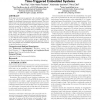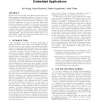ECBS
2007
IEEE
14 years 5 months ago
2007
IEEE
There is an ever increasing concern about security threats as embedded systems are moving towards networked applications. Model based approaches have proven to be effective techni...
DSD
2007
IEEE
14 years 5 months ago
2007
IEEE
Developing highly efficient and reliable embedded systems demands hardware/software (HW/SW) co-design and, therefore, co-simulation. In order to be highly configurable, embedded...
DATE
2007
IEEE
14 years 5 months ago
2007
IEEE
Partitioning a memory into multiple blocks that can be independently accessed is a widely used technique to reduce its dynamic power. For embedded systems, its benefits can be ev...
CODES
2007
IEEE
14 years 6 months ago
2007
IEEE
In this paper we present an approach to the scheduling and voltage scaling of low-power fault-tolerant hard real-time applications mapped on distributed heterogeneous embedded sys...
SIES
2008
IEEE
14 years 6 months ago
2008
IEEE
—Distributed, time-triggered communication based on FlexRay is likely to become an enabler for future safety related applications in the automotive domain. Prior to series deploy...
SIES
2008
IEEE
14 years 6 months ago
2008
IEEE
Abstract— Not only system performance but also energy efficiency is critically important for embedded systems. Optimal real-time scheduling is effective to not only schedulabili...
SIES
2008
IEEE
14 years 6 months ago
2008
IEEE
—Chip multiprocessing design is an emerging trend for embedded systems. In this paper, we introduce a Java multiprocessor system-on-chip called JopCMP. It is a symmetric shared-m...
SIES
2008
IEEE
14 years 6 months ago
2008
IEEE
SystemC becomes popular as an efficient system-level modelling language and simulation platform. However, the solethread simulation kernel obstacles its performance progress from ...
SIES
2008
IEEE
14 years 6 months ago
2008
IEEE
SEUS
2008
IEEE
14 years 6 months ago
2008
IEEE
In this study, we propose ARF-aware TCP that resolves the performance anomaly in 802.11 WLAN networks. Performance anomaly is a network symptom that fairness among the nodes is bro...



